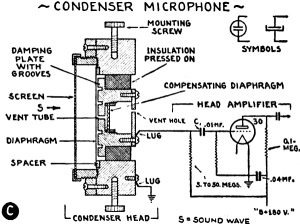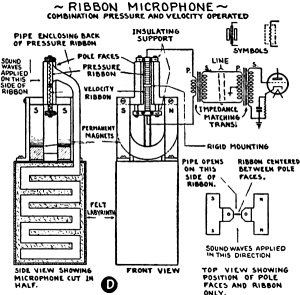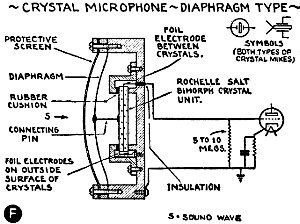|
August 1938 Radio-Craft
 [Table
of Contents] [Table
of Contents]
Wax nostalgic about and learn from the history of early electronics.
See articles from Radio-Craft,
published 1929 - 1953. All copyrights are hereby acknowledged.
|
Carbon button microphones were
used in Alexander Graham Bell's first production model telephones. He bought the
patent from inventor
Emile Berliner because they were superior to Bell's own liquid
element microphones. Condenser
microphones followed, whose transducer element includes an integral variable
capacitor. Interestingly, even though we in the U.S don't refer to capacitors as
"condensers" anymore, the name has persisted. Ribbon microphones are inexpensive and bidirectional (front
and back of diaphragm). Moving
coil microphones are more rugged than previous configurations and are not as
prone to weather variations. Crystal microphones utilize piezoelectric properties
of a crystal for generating electrical signals.
Electret microphones, which
came on the scene after this article was written, overwhelmingly dominate the microphone
market today because they are used almost exclusively in computers, hearing aides,
and mobile devices.
Microphones Explained for Beginners
Fundamental principles of operation of every basic type of microphone in general
use today are described. Construction details of high-quality units are illustrated.
The 5 most common types of microphones used for P.A. systems and broadcast studio
work are:- the carbon, condenser, ribbon or velocity, dynamic or moving coil, and
crystal. Each one has its advantages and disadvantages and so we shall consider
each type in the order named.

Single-Button Carbon Microphone
Carbon Microphones
The carbon microphone depends for its operation on the varying resistance of
a carbon element when subjected to varying pressure.
The usual arrangement of this type unit, for best fidelity, consists of 2 carbon
buttons one on either side of the diaphragm. This metal diaphragm - in a properly-built
carbon microphone - is stretched and air damped so that the effects of self-resonance
vibrations are negligible, giving a reasonably uniform output at all ordinary audio
frequencies.
This unit has the disadvantage of a background noise called "carbon hiss," which
is caused by the passage of current through the granules. It has a high maintenance
factor and must be handled with care. On the other hand it has the advantage of
a very good power output level of -30 db., together with low output impedance, making
it possible to have the microphone some distance from the amplifier. See Fig. 1,
A and B.

Double-Button Carbon Microphone

Condenser Microphone

Ribbon Microphone

Moving-Coil Microphone

Crystal Microphone, Diaphragm Type

Crystal Microphone, Sound Cell Type
Condenser Microphones
The diaphragm of the condenser microphone constitutes one of the plates of a
variable air condenser, while the back plate, which is separated from the diaphragm
by a film of air about 1/1,000 in. thick, acts as the other plate. See Fig. 1C.
Capacity variations of this condenser, in series with coupling condenser C, develop
minute A.F. voltages which are then amplified by a 1- or 2- stage "head" amplifier.
In actual practice, the condenser and head amplifier (or preamplifier") are all
housed in the same case and the whole unit is called a condenser microphone.
After the signal leaves the head amplifier, it has about the same output level
as that of a double-button carbon type. The same principle of stretching and damping
the diaphragm is applied to the condenser type as is used in the carbon microphone,
thus giving about the same fidelity of output. However, there is a noticeable absence
of background hiss, and the ruggedness of the unit is a decided advantage.
Ribbon or Velocity Microphones
The ribbon-type microphone is so named because the armature is a light corrugated
ribbon of aluminum alloy. See Fig. 1D. This type is also called a velocity
microphone because the voltage induced in the ribbon is proportional to the instantaneous
velocity of the air in the sound wave. The aluminum ribbon is suspended in the field
of a permanent magnet and when sound waves strike the ribbon it vibrates, cutting
the magnetic lines of force.
Whenever a moving conductor cuts lines of magnetic force, an electromotive force
is induced in the conductor. Thus in this case we will have set up in the ribbon
a small e.m.f. whenever it vibrates. Since the mass of the ribbon is extremely low,
an excellent frequency response is obtained, extending well beyond the upper limits
of the regular stretched-diaphragm-type microphone.
This extended range of audio response is not very important as far as speech
is concerned but does add brilliance to the reproduction of sound from musical instruments.
The output of this unit is approximately the same as that of a condenser-type
microphone, so it also requires a 2-stage amplifier to bring the output level up
to about -30 db.
The velocity microphone is a low-impedance device, but it always has a coupling
transformer mounted right in the microphone case. By matching the line impedance
to that of this coupling transformer, the amplifier may be located some distance
from the unit itself, provided the connecting cable is, properly shielded.
This type microphone is of a rugged nature and also possesses a very marked directional
effect, the greatest response being obtained at right-angles to the plane of the
ribbon; an "acoustical labyrinth" is sometimes provided to enhance the directional
characteristic by absorbing 1/2 the backwave. The construction of the microphone
is of such a nature that its operation is very quiet and free from noise or hiss.
Dynamic Microphones
The operation of the moving coil or dynamic microphone, like the dynamic loudspeaker,
is fundamentally that of a conductor moving in a magnetic field, thus generating
an e.m.f in the conductor. See Fig. 1E. The diaphragm is made of thin duralumin
which - in a high-grade unit - is pressed into a dome shape for stiffening to secure
a piston action over the audio frequency range; improved frequency response is achieved
by providing an "air passage" to afford outlet for the backwave.
The moving coil is made from thin aluminum ribbon cemented to the diaphragm,
and moves in the air gap between the pole pieces. The permanent magnet is composed
of cobalt alloy steel, which will remain magnetized for a long period of time.
The moving coil microphone is quite rugged and is not affected by climatic conditions.
Its output level is approximately 10 db. higher than that of the condenser-type
microphone, or about -80 db.
The low impedance of the dynamic microphone makes it possible to locate the preamplifier
some distance from the microphone itself. The frequency characteristic of the dynamic
microphone is quite uniform from 35 to 10,000 cycles, so it has very good fidelity
response to sounds in the normal audio range. This type unit has no inherent noise,
and due to its very rugged construction can stand quite a bit of rough handling.
Crystal Microphones
Two types of crystal microphones are in common use today, to wit: 1st, the sound-cell
type (See Fig. 1G.) in which the sound waves act directly upon the crystal;
and 2nd, the diaphragm type (See Fig. 1F.) which uses a diaphragm to the center
of which the crystal is attached by means of a mechanical link. In either of these
units, the principle of operation depends upon the piezoelectric effect or voltage
produced in certain crystals when subjected to mechanical stress (bending, etc.).
The sound-cell unit is an assembly of 2 "bimorph" Rochelle salt crystal elements
in a bakelite frame. The bimorph elements, in turn, are each made up of 2 crystal
plates with electrodes attached, cemented together so that an applied sound will
cause a bending of the assembly, and produce a voltage. The mounting is such that
mechanical shocks have little effect on the unit.
No diaphragm is used, the sound impulses actuating the crystal elements directly.
An exceptionally wide frequency range, even into the super-audible band and on down
to zero frequency, may be obtained from this unit. Of the 2 types of crystal microphones,
the sound-cell has the better frequency characteristics. Its output is very low,
however, so it requires greater amplification. This type of crystal microphone is
usually employed for full-range musical pick-up.
The diaphragm type will give much greater output, eliminating in most cases the
need for a preamplifier, but it has the disadvantage of limited frequency response.
This type of crystal microphone is most used for voice work.
This article has been prepared from data supplied by courtesy of Coyne Electrical
School.
Posted August 23, 2022
(updated from original post
on 11/11/2014)
|



































